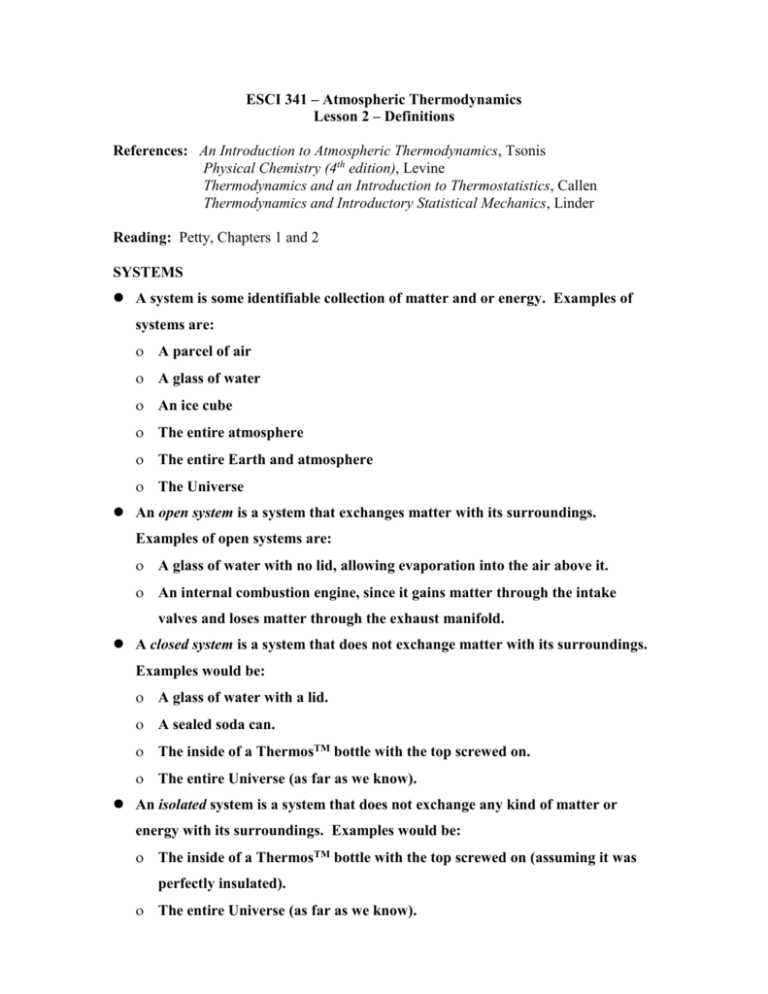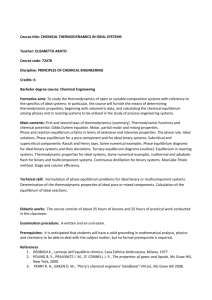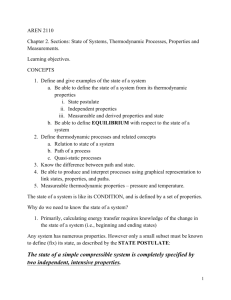ESCI 341 – Atmospheric Thermodynamics Lesson 2 – Definitions
advertisement

ESCI 341 – Atmospheric Thermodynamics Lesson 2 – Definitions References: An Introduction to Atmospheric Thermodynamics, Tsonis Physical Chemistry (4th edition), Levine Thermodynamics and an Introduction to Thermostatistics, Callen Thermodynamics and Introductory Statistical Mechanics, Linder Reading: Petty, Chapters 1 and 2 SYSTEMS A system is some identifiable collection of matter and or energy. Examples of systems are: A parcel of air A glass of water An ice cube The entire atmosphere The entire Earth and atmosphere The Universe An open system is a system that exchanges matter with its surroundings. Examples of open systems are: A glass of water with no lid, allowing evaporation into the air above it. An internal combustion engine, since it gains matter through the intake valves and loses matter through the exhaust manifold. A closed system is a system that does not exchange matter with its surroundings. Examples would be: A glass of water with a lid. A sealed soda can. The inside of a ThermosTM bottle with the top screwed on. The entire Universe (as far as we know). An isolated system is a system that does not exchange any kind of matter or energy with its surroundings. Examples would be: The inside of a ThermosTM bottle with the top screwed on (assuming it was perfectly insulated). The entire Universe (as far as we know). The relationship between open, closed, and isolated systems can be illustrated using a Venn diagram. From this diagram we see that The set of all open systems does not intersect the set of all closed systems. Every system is either open or it is closed. The set of all isolated systems is a subset of the set of all closed systems. In plain language, we can infer the following: Any isolated system is also a closed system, but a closed system is not necessarily an isolated system. An open system cannot be an isolated system. Any matter or energy that is not part of the system is considered to be part of the surroundings or environment. EQUILIBRIUM There are three types of equilibrium: Mechanical equilibrium – This means there are no unbalanced forces, so that neither the system, nor any part of the system, undergoes accelerations. This also implies that there is no turbulence within the system. Material equilibrium – This means that there is no net transfer of matter from one phase or component of the system to another. The concentrations of chemical species and their phases are constant with time. Thermal equilibrium – Means that the individual parts or pieces of the system would remain in the same state whether or not they were connected by a thermally conducting wall. In practicality, this means that there are no temperature gradients in the system. 2 A system is in thermodynamic equilibrium only if it is in mechanical, material, and thermal equilibrium. TYPES OF ENERGY Potential energy, which can be due to Gravitational field (PE = mgh) Electrical/magnetic field Spring or elastic band Molecular bonds Kinetic energy, which is the energy of motion Motion of bodies (KE = ½ mv 2) Motion of individual molecules in a body Thermal energy – The sum of the kinetic energy of all the molecules in a substance Internal energy – The sum of the thermal energy and any potential energy due to the forces between the molecules of a substance. Einstein’s theory of special relativity established the equivalence of energy and mass, via E = mc2, so that mass is also a form of energy. STATE VARIABLES AND THE FUNDAMENTAL EQUATION The state of a system is defined by the position and momentum of every piece of matter in the system. For a cubic meter of air at sea level this requires the knowledge of the position and momentum of every 2.561025 molecules in the volume! It is impossible to measure or know the state of the system as defined above. Therefore, we content ourselves with knowing something about the “average” or macroscopic properties of the system as a whole. This is what the subject of thermodynamics attempts to do. 3 The thermodynamic state of a simple system in thermodynamic equilibrium is completely characterized by specifying the internal energy (U), volume (V), and the number of moles, ni, of each of its components1. Example: If the system consists of a closed container of liquid water and water vapor, then there are four state variables: U, V, nliquid, and nvapor. The fundamental equation relates the entropy (another state variable denoted as S) to U, V and ni, as S f (U ,V , ni ) (1) Equation (1) says that if U, V, and ni, are known, then the entropy, S, can be found. Knowledge of the fundamental equation implies complete knowledge about the thermodynamic state of the system. S, U, V, and ni are referred to as state variables, because they describe the thermodynamic state of the system. If the system is not in thermodynamic equilibrium then additional variables are needed to describe the thermodynamic state of the system. We will confine ourselves mostly to systems in equilibrium. The fundamental equation, (1), can also be written as U f (S ,V , ni ) (2) where the only difference between Eqs. (1) and (2) is whether U or S are independent or dependent variables. U, V, and n are not the only possible state variables. Other state variables can be derived from U, S, V, ni, and their derivatives, via equations called equations of state. Other state variables we will use will include pressure (p), mass (m), density (), temperature (T), enthalpy (H), etc. In general: For a one-component system in equilibrium we need 3 state variables. For a two-component system in equilibrium we need 4 state variables. For a three-component system in equilibrium we need 5 state variables. For a j-component system in equilibrium we need j + 2 state variables. 1 The masses of the substances present could be used in place of the number of moles. 4 EXTENSIVE VERSUS INTENSIVE VARIABLES An intensive property is one that does not depend on how much substance is present. Temperature is an example of an intensive property. If two identical masses are at the same temperature and are added together, the temperature remains the same even though the mass is doubled. An extensive property depends on how much substance is present. Internal energy is an example of an extensive property. If the two identical masses are added together there is twice as much internal energy. There are two ways to convert an extensive property into an intensive property. Divide by the mass. The result is a property that is normalized by the mass. We add the term specific to indicate that we’ve divided by the mass. For example, the specific internal energy u is defined as U/m. Divide by the number of moles. The result is a property that is normalized by the number of moles present. We add the term molar specific to indicate we’ve divided by the number of moles. For example, the molar specific internal energy, um, is defined as U/n. In general, extensive properties are denoted using upper-case letters, while intensive properties are denoted using lower-case letters. However, there are exceptions, including ONE NOTABLE EXCEPTION: Temperature is denoted using upper-case T, even though it is an intensive property. TRANSFORMATIONS A system that moves from one equilibrium state to another will experience a change in state variables. The initial and final equilibrium states can be represented on a thermodynamic diagram. Note that only equilibrium states of a closed system can be represented on a 2dimensional thermodynamic diagram. Why is this? There are an infinite number of paths on the diagram by which the system can be transformed from one equilibrium state to another. However, regardless of 5 which path is taken, the change in the state variables will be the same between the two points. We can express this property of state variables mathematically in two ways: The change in any of the state variables (say U) doesn’t depend on the path of the system on a thermodynamic diagram. It only depends on the endpoints. b dU U (b) U (a) a The integral of a state variable around a closed path is zero. dU 0 Mathematically, this means that differentials of state variables are exact differentials. In order to be a state variable, the differential of the variable must be exact. REVERSIBLE AND IRREVERSIBLE PROCESSES A quasi-static process is a process that proceeds through a sequence of equilibrium states that are spaced infinitesimally close together. A quasi-static process is almost always nearly in equilibrium. It is not in equilibrium between successive equilibrium states, but since the equilibrium states are infinitesimally close, the time spent out of equilibrium is very small. A quasi-static process must proceed infinitesimally slow, so that the system is always nearly in equilibrium. Each equilibrium state can be represented on a thermodynamic diagram, and since they are infinitesimally close, a quasi-static process would appear as a path or curve on the thermodynamic diagram. However, if the curve is magnified, it would be apparent that it is not continuous, but consists of a series of infinitesimally spaced dots. A reversible process is a quasi-static in which the system is always in equilibrium, so the curve on the thermodynamic diagram is continuous, even when magnified. 6 For a reversible process, at any point the transformation can be stopped and then made to proceed in the exact opposite direction. An irreversible process is a process (quasi-static or not) that cannot be reversed. Examples of irreversible processes are Free expansion of a gas. Mixing of two gasses. Note the following rules: All reversible processes are also quasi-static processes. Not all quasi-static processes are reversible processes. An irreversible process may also be quasi-static. No real processes are truly quasi-static or truly reversible. We often assume, however, that some real processes are quasi-static or reversible because it makes doing thermodynamics so much easier, and the errors are often not significant. NOTE ON QUASI-STATIC VERSUS REVERSIBLE There are different and conflicting definitions for quasi-static in the literature. Our definition follows that of Callen (1986) and Linder (2004). However, there are others who define quasi-static such that the terms quasistatic and reversible are used interchangeably. 7






